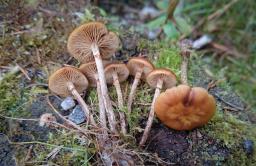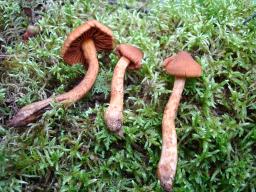The most poisonous mushrooms in Finland
There are about 50 poisonous mushrooms in Finland, five of which can cause life-threatening poisoning even in small amounts. Those mushrooms are destroying angel, death cap, funeral bell, deadly webcap and false morel.
Always call the Poison Information Center for risk assessment and further instructions. Keep the mushroom for possible later identification.
Destroying angel (Amanita virosa)

The destroying angel is a deadly poisonous mushroom containing amatoxins which are toxic to the liver. Symptoms usually begin 6–24 hours after ingestion. Initial symptoms include severe abdominal pain, vomiting and watery diarrhea.
The destroying angel is completely white. When young, the cap is egg-shaped, while older ones have a flared cap that is 3 to 12 cm wide. The stem is white, 5 to 15 cm long, with an annulus and volva. This mushroom grows in all of Finland in habitats such as spruce forests, coniferous swamps and groves from August to September. The destroying angel can be mistaken for button mushroom and paddy straw mushroom.
Death cap (Amanita phalloides)

The death cap is a deadly poisonous mushroom containing amatoxins which are toxic to the liver. Symptoms usually begin 6–24 hours after ingestion. Initial symptoms include severe abdominal pain, vomiting and watery diarrhea.
When young, the cap of a death cap is egg-shaped, while older ones have a flatter, wider cap (5 to 15 cm wide) whose colour is a mix of olive green and yellowish grey (or white). The stem is white, 7 to 15 cm long, with an annulus and volva. The death cap is a rare species in Finland, growing in Southwest Finland (Åland, Turku Archipelago, Uusimaa). It grows in groves and pasturage from August to September. The death cap can be mistaken for button mushroom and green-coloured russula.
Funeral bell (Galerina marginata)

Like the destroying angel and the death cap, the funeral bell contains amatoxins which are toxic to the liver.
When damp, the cap is dark brown and when dry, it is light golden brown and 1 to 5 cm wide. The centre of the cap is raised. The stem is 2 to 7 cm long, thin and brown, darker at the base. The stem has thin annulus and below it light-coloured fibrils. This mushroom is common throughout Finland. It typically grows on decaying coniferous wood, for example in forests and felled areas, or on plantlitter in gardens and on forest tracks from September to November. The funeral bell can be mistaken for sheathed woodtuft.
Deadly webcap (Corinarius rubellus)

The deadly webcap is a deadly poisonous mushroom containing orellanine, which is toxic to the kidneys. The onset time of symptoms caused by the deadly webcap varies (between 12 hours and 14 days), while most typically the symptoms (including vomiting and abdominal pain) begin after 3 days.
The cap of a deadly webcap is reddish brown or cinnamon brown, 3 to 8 cm wide, and it is raised in the middle. The stem is 0.5 to 1.5 cm thick and 5 to 13 cm long. The deadly webcap grows commonly throughout Finland in young spruce forests, coniferous swamps, on the edges of wetlands, often in sphagnum moss, from August to September. The deadly webcap can be mistaken for other webcaps and the rufous milk-cap.
False morel (Gyromitra esculenta)

The false morel is toxic when raw or insufficiently processed, containing gyromitrin, which may cause liver damage at worst. Symptoms usually begin 4–12 hours after ingestion. Initial symptoms include vomiting, diarrhoea, abdominal pain and dizziness.
The cap of the false morel is brown, 4 to 12 cm wide with brain-like folds, it is hollow and resembles funnel cake. The stem is light grey and 2 to 5 cm long. This mushroom grows commonly throughout Finland, for example in sandy coniferous forests and clear-felled areas. The harvest season is from April to June. The false morel can be mistaken for true morel and hooded false morel.
Myrkytystietokeskuksen haku
Voit etsiä tietoa eri sienten, kasvien ja aineiden myrkyllisyydestä Myrkytystietokeskuksen hausta.
